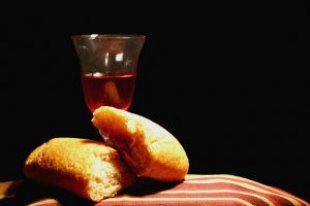Q. I want to know the reasons why Catholics believe in the true presence in regards to communion, and why Protestants believe that communion is symbolic. I’m thinking it might be because Catholics take statements like “I am the bread” more literally, but I’m wondering what the theological reasons are as well.
The meaning of communion (or the Lord’s Supper or Eucharist) is so important for groups of believers to discuss and understand that several of the study guides in the Understanding the Books of the Bible series provide opportunities for groups to engage this issue together. In the John study guide, for example, at the place where Jesus feeds five thousand people by the Sea of Galilee and then talks about “eating his flesh” and “drinking his blood,” group members are invited to share how their community of Jesus’ followers (if they belong to one) observes the Lord’s Supper: What is believed about the elements? How are they served? Who may participate? And so forth. People are also invited to talk about the most meaningful experiences they’ve had sharing in the Lord’s Supper. (The question comes at this point in the study guide because John doesn’t actually depict Jesus instituting communion at the Last Supper.) A similar opportunity is given in the guide to Paul’s Journey Letters, in the session that discusses Paul’s teaching about the Lord’s Supper in 1 Corinthians. In the Psalms guide, to give another example, communion is discussed in the context of psalms of thanksgiving, which were sung at community meals celebrating God’s deliverance. These meals were the historical forerunners of the Lord’s Supper in the life of the covenant people.
But to answer your question specifically, the theological term for the Catholic belief about communion is transubstantiation. This refers to the classical belief that objects have an inward part, an “essence” or “substance” (meaning that which “stands under”: sub-stantia), in which their deepest being consists. They also have surface characteristics, or “accidents.” Thus, in this frame of reference, a person’s “substance” or “essence” would be their humanity, while things like blue eyes, blond hair, height, etc. would be incidental or “accidental” characteristics.
 The Catholic belief is that the communion elements (the bread and the wine) “become” the body and blood of Christ as their substance is transformed into those things (thus trans-substan-tiation). The bread and wine retain their accidental characteristics, however, and thus still look and taste like bread and wine. This belief is based not only a a literal interpretation of statements such as “this is my body, this is my blood” but on this whole philosophical framework that makes it possible to believe that the bread and wine really are the body and the blood, even if they don’t look like it. Christ is understood to be really present in his body and blood, which now constitute the essence of the elements, thus the reference to the “Real Presence” of Christ at the communion table.
The Catholic belief is that the communion elements (the bread and the wine) “become” the body and blood of Christ as their substance is transformed into those things (thus trans-substan-tiation). The bread and wine retain their accidental characteristics, however, and thus still look and taste like bread and wine. This belief is based not only a a literal interpretation of statements such as “this is my body, this is my blood” but on this whole philosophical framework that makes it possible to believe that the bread and wine really are the body and the blood, even if they don’t look like it. Christ is understood to be really present in his body and blood, which now constitute the essence of the elements, thus the reference to the “Real Presence” of Christ at the communion table.
During and after the Reformation, some Protestants continued to believe in transubstantiation, or something similar to it. Anglicans (Episcopalians) believe in transubstantiation and Lutherans believe in consubstantiation, in which the body and blood become mingled with the essence of the bread and wine. But other Protestants, particularly those coming in the historic stream leading from the Geneva reformers (such as Presbyterians, Congregationalists and Baptists), moved to a symbolic view, in which the bread and wine represent the body and blood.
In a famous debate with Martin Luther, Ulrich Zwingli championed the “memorial” or symbolic view by appealing to the Scripture that says, “The letter kills, but the Spirit gives life.” Zwingli was especially concerned with combating what had become a superstition in which the “body and blood of Christ” were some kind of super food that protected people from spiritual harm. From this point of view, even though Christ is not “really present” in the elements, they point to him, and sharing at the table is still obedience to his command to “remember me.” The believers who gathered to share the supper together are understood to be the “body of Christ” themselves.
The disagreement between Luther and Zwingli presaged the later move within modernity and the Enlightenment to the “phenomenal” (seen) and away from the “noumenal” (unseen). If all you could see and taste were bread and wine, then maybe that’s all there was on the table. In other words, the modern reliance on the senses alone might have been starting to come through in Zwingli’s position. This modern world view makes it more difficult for many people to appreciate and understand the Catholic understanding, which is based on a more classic view of matter and being. But ultimately what we believe about the bread and wine of communion is a matter of faith, and followers of Jesus should respect and honor one another’s beliefs.
